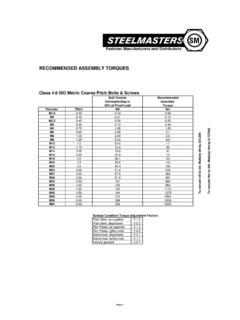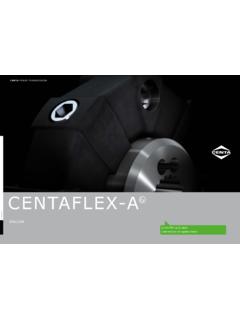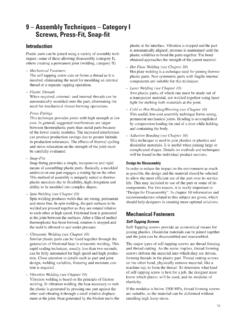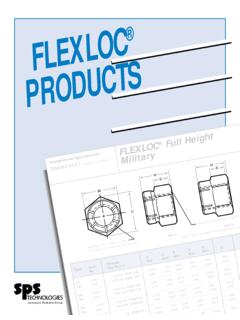Transcription of DESIGN DRAWING STANDARDS
1 DESIGN DRAWING STANDARDS . TM. AND TOLERANCES INDEX. assembly 05/29/15. PAGE DATE DESCRIPTION. A-1 02/13/08 DESIGN DRAWING STANDARDS and Tolerances Index A-2 09/07/99 Metric Drafting STANDARDS A-3 02/13/08 Metric Drafting STANDARDS A-4 04/06/06 Metric Drafting STANDARDS A-5 05/29/15 Metric Drafting STANDARDS A-6 03/01/96 Tolerance stickers A-7 09/07/99 Installation Torques for Metric Screws A-8 10 02/12/97 Bill Of Materials Instructions A-11 15 02/12/97 System Instructions A-16 18 02/12/97 assembly Line Instructions A-19 20 09/01/00 assembly Line Instructions A-21 02/12/97 Tool Instructions A-22 09/01/00 Tool Instructions A-23 02/12/97 Tool Instructions A-24 25 09/01/00 Tool Instructions A-26 27 02/12/97 Unit Instructions A-28 29 09/01/00 Unit Instructions A-30 33 02/12/97 Unit Instructions A-34 09/01/00 Unit Instructions A-35 02/12/97 Templates A-36 02/12/97 System Template A-37 09/15/00 Line Template A-38 09/15/00 Tool Template
2 A-39 02/12/97 Unit Template 1997 Auto/Steel Partnership This document is Uncontrolled when printed. A-1. G L O B A L S TA N D A R D C O M P O N E N T S. METRIC DRAFTING. STANDARDS TM. assembly 09/07/99. 1. INTRODUCTION. These Metric Drafting STANDARDS are an integral part of the NAAMS Global A. Standard Components, assembly . 2. DEFINITIONS. Hard Metric: A dimension in millimeters, established in metric and not a result of converting from customary units to equivalent metric. Soft Metric: A dimension in millimeters, resulting from directly converting an established customary base dimension. 3. DRAWING PROJECTION. Current drafting practices pertaining to multiview and sectional view draw- ings are defined and illustrated in ANSI Y - 1994. All drawings should be drafted using third angle projection on orthographic views. When sections or views are projected on the same or on other sheets, they shall be projected and drawn perpendicular to the cutting or viewing plane.
3 When sections or views are projected onto other sheets, directional arrows shall be shown and cross referencing notes added onto the respective view. 4. CONSTRUCTION MATERIAL. When plate, tubing, angles, channels, etc. that are produced to cus- tomary units are specified, the cross section dimensions should be called out in customary units and the cut length in metric. 5. TRANSFERS. Transfers within a tooling system shall have their construction dimensioned in metrics. Travel distance, both horizontal and vertical, shall be dimensioned in metrics, with equivalent customary setup dimensions to interface coordination points with plant facilities and plant equipment. 6. FASTENERS. It is recommended that all tool builders and suppliers use only hard metric fasteners. All metric threads are assumed to be coarse unless otherwise specified. The preferred minimum screw size is M8, except for the attachment of commercial and standard items that have predetermined mounting holes.
4 Fasteners for kits shall remain to their existing standard screw size. 7. ENERGY, INERTIA, torque , POWER AND WORK. These entities shall remain to current STANDARDS . For future customary / metric conversion, refer to the NAAMS Metric Equivalent Charts #1 & #2. 8. DIMENSIONING AND TOLERANCING. Dimensioning and tolerancing practices shall be as defined and illustrated in ANSI Specification # - 1994. A zero before the decimal point shall be used for a number less than (Example ). 1997 Auto/Steel Partnership This document is Uncontrolled when printed. A 2. G L O B A L S TA N D A R D C O M P O N E N T S. METRIC DRAFTING. STANDARDS TM. assembly 02/13/08. 9. METRIC DRAWING SCALE. For general DESIGN work, DRAWING scales shall be full size wherever possible. The recommended reduced scale for fixture designs are 1:2, 1:5, 1:10, 1:20. and 1:50. When increased scales are necessary, the scales shall be 2:1, 5:1, 10:1.
5 20:1 and 50:1. The DRAWING scale for system layout drawings should be coordinated with each individual plant. 10. LETTERING. All text height shall be 2 mm minimum on 11 x 17 CAD drawings and 3 mm minimum on all other drawings. Notes and descriptions shall be 5 mm minimum. View callouts, section, unit no's, switch and cylinder callouts shall be 7 mm minimum. 11. BODYLINES. On fixture drawings, only one body line is required in each direction provided its relationship to the zero datum line is shown. These shall be identified with a 25 mm diameter balloon. All auxiliary worklines shall be identified with a 25 mm square box, showing originating bodyline intersection and angle used for worklines. When a dimension originates from a workline, the origin should be indicated. 12. DIMENSION ARRANGEMENT. Dimensions should be shown in true views and should not be taken from hidden lines.
6 Dimensions should be located outside the outline of the detail wherever possible. Screw and dowel sizes shall be written along the center-line of the fastener in its side view on assembly drawings. 13. COMMERCIAL COMPONENTS. Metric commercial components are preferred when available and approved by customer. Pivot shaft diameters, bushing & bearing sizes, cylinders and stroke of cylinders etc., shall remain to existing STANDARDS . Gears, racks, etc., shall retain inch pitch diameters. Pipe threads shall remain to existing STANDARDS . 14. SETUP DIMENSIONS. Machined surfaces, pivot centerlines, hole patterns, fab dimensions and NC. block mounting surfaces should be set up in 5 mm increments whenever possible. 15. DETAILS OF A UNIT. All items that are detailed shall be identified with a 20 mm diameter split balloon with the item number of the detail in the top half and the sheet number where the detail is drawn in the bottom half.
7 If a detail is shown & opposite on a particular unit, the same detail number should be used with SHN. and OPP. written alongside the A. appropriate balloon. 1997 Auto/Steel Partnership This document is Uncontrolled when printed. A 3. G L O B A L S TA N D A R D C O M P O N E N T S. METRIC DRAFTING. STANDARDS TM. assembly 04/06/06. For all items that are not detailed, such as purchased and standard items, the balloon shall contain only the identification number of the detail; no sheet number is required. 16. READING DIRECTION. Unless otherwise specified, all dimensions and notes should be placed on the DRAWING so that they may be viewed from the bottom of the sheet. 17. OUT OF SCALE. Dimensions out of scale should be avoided, but when a dimension cannot be made to scale (as a result of a DRAWING revision), then the dimension should be underlined.
8 (Example: DIA.) A. When details must be shown broken due to sheet size restrictions, the dimension for the missing section shall be written. 18. CHANGES. The information recorded in the change column should be brief and accu- rate, but complete to the extent that the DRAWING could be reverted back to its original form. A change letter used when recording a change should continue to be used on all of the affected sheets ( assembly , , etc.) pertaining to that change. A change letter (upper case) should be enclosed in a 6 mm diameter balloon. All changes should be recorded in the change column on the affected sheet or sheets. Change letters should be placed in a vertical row in the change column. A change letter and balloon should be placed near the revision on the affected sheet. A change letter and balloon should also be placed at the bottom and end of the sheet (title block end) outside the border for ease of locating revisions made to the DRAWING .
9 19. STOCK LIST OR BILL OF MATERIALS. Stock lists or bills of material should not be shown on layout drawings. (See Bills of Material in this section.). 20. FAB O LINE DIMENSIONING. Fab O line dimensions should always start from the same edges as the machining datum line start dimensions. Primary Fab O lines (X, Y & Z planes) should be established on the pri- mary sub-detail. (Usually the largest sub-detail or the footprint of the detail.). All fab setup dimensions for sub-details should be dimensioned from the two primary Fab O lines. When sub-details require CUT dimensions, secondary Fab O lines should be established for that particular sub detail. The Fab O line callout should reflect the sub-detail item letter. Example: Fab O line A , Fab O line B etc: these cut dimensions are used only for the specific sub-detail that is being defined. 1997 Auto/Steel Partnership This document is Uncontrolled when printed.
10 A 4. G L O B A L S TA N D A R D C O M P O N E N T S. METRIC DRAFTING. STANDARDS TM. assembly 05/29/15. 21. HOLES AND SLOTS. All tapped, dowel and clearance holes on details are assumed to be through; it will no longer be specified on a DRAWING that the hole is THRU . When a hole requires that a depth be specified, the depth shall be incorpo- rated into the hole callout. Construction holes are assumed to be through as shown on the DRAWING , or to a cross hole if applicable. Depths for counterbored holes shall not be specified unless they are non- standard, in which case AS SHOWN should be noted on the DRAWING . All tapped holes are assumed to have coarse threads unless otherwise specified. On detail drawings with 3 or more hole sizes, holes shall be tabulated using the label shown. AFTER DOWEL SIZE, H6 INDICATES. # PRESS FIT AND F7 INDICATES SLIP FIT.






